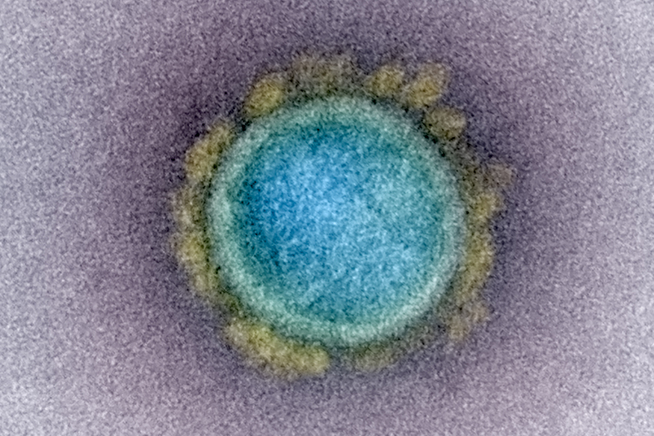
A coronavirus is swallowing the world’s attention and pushing scientists to study the virus and gain new insights at a dizzying pace, making it difficult for those without expert knowledge to keep up.
Dr. Michael Emerman, a Fred Hutchinson Cancer Research Center virologist, has studied the interaction between the immune system, HIV and related viruses for 30 years.
He teaches a 10-week course on viruses to Fred Hutch and University of Washington graduate students, including a lecture on viral pandemics.
This year he repeated a version of this lecture virtually, drawing on data from the 2003 SARS outbreak and the 2009 swine flu to give context to the pandemic being caused by this novel coronavirus.
We adapted some of this information to create a short primer on coronavirus biology and the scenarios that may play out in the coming months.
First, a point of clarification about COVID-19 and SARS-CoV-2.
“The virologist in me has to point out: they’re not the same thing,” Emerman said.
Just as we distinguish between the virus HIV and AIDS, the disease it causes, we distinguish between SARS-CoV-2, the virus, and COVID-19, the disease it causes.
SARS-CoV-2 — new but not unique
Though new and potentially deadly, SARS-CoV-2 is not the first coronavirus we humans have encountered. In addition to the coronavirus that caused the sudden and short-lived outbreak of SARS in 2003, four coronaviruses currently circulate among humans.
Three of them cause about 15% to 20% of colds, while the fourth coronavirus is responsible for about 2% to 5% of cases of croup.
We typically encounter these coronaviruses as children.
“In general, it seems to be a biological property of coronaviruses that they are much less severe in young children than they are in adults,” Emerman said.
Getting the disease as a child appears to offer some protection against reinfection later in life; adults encountering these coronaviruses for first time generally have more severe disease than those who were first infected as children, Emerman said.
It is believed that immunity to a coronavirus-caused cold typically lasts about three to five years and that subsequent reinfections are less severe.
Where does SARS-CoV-2 attack?
Where a virus replicates can dictate the infection’s symptoms. The cold-causing coronaviruses replicate in the cells lining the upper respiratory tract and trigger symptoms like sneezing and a runny nose.
In contrast, SARS-CoV-2 primarily infects cells — and does most of its replicating — deep within the lungs.
Current studies show that it also replicates in the nasal passages and upper airway, which may help it transmit more easily than other lower respiratory tract infections.
“Coughing and droplets from the mouth are the major way it is spreading,” Emerman said. The fact that SARS-CoV-2 primarily targets the lower respiratory tract also contributes to the worrisome lung damage it can cause, he said. “The upper respiratory tract is less susceptible to damage, so infections to the upper respiratory tract are going to be less deadly.”
Coronavirus testing
So why are we testing for the novel coronavirus by running swabs in people’s noses and the back of their throats? While there are hints that SARS-CoV-2 may replicate in both the lower respiratory tract and nasal passages, the swabs are also detecting virus that has been coughed up from lower down, Emerman said.
“That’s part of why you can have false negatives,” he said. Someone infected with SARS-CoV-2 deep in their lungs may not have coughed up enough virus to be detected via swab.
If they do test later, their results can flip to positive. But for large-scale screening, nose and throat swabs are still the best strategy, Emerman said; sampling deep in the lungs is too invasive.
Coronavirus biology explains its stability
Much of the public health recommendations for reducing the spread of SARS-CoV-2 focus on its ability to linger to linger on surfaces in our environment. It turns out that coronavirus particles are more stable than influenza virus particles.
Learn more about the distinctive structure of SARS-CoV-2 in this companion story, What’s with the spikes?
The flu and coronaviruses transmit to new cells by bundling their genetic material into virus particles. But the flu also packages proteins with specialized activity, called enzymes, to facilitate entry into target cells. Coronaviruses don’t need to add enzymes to their particles because they co-opt host-cell enzymes to slip inside cells.
But enzymes quickly lose activity. By including them, flu viruses limit their shelf life. By leaving enzymes behind, coronaviruses extend the time that they stay infectious outside the body, Emerman explained.
The fact that some coronaviruses (not the four mild ones circulating among humans) cause gastrointestinal infections in animals like pigs also underscores their ability to remain stable in harsh environments that other viruses can’t withstand, he said.
What will the future hold?
“It’s complicated and we don’t know yet,” Emerman said.
The are many factors that could influence ebb and flow of coronavirus infections over the coming year, he said.
The most optimistic, best-case scenario — that the globe will come together to stop the pandemic before fall — will depend on how well we in the Northern Hemisphere implement physical distancing measures and how well countries in the Southern Hemisphere prepare for SARS-CoV-2 as their winter looms, Emerman said.
“If it is not controlled in the Southern Hemisphere in their winter, it may well be back [in the Northern Hemisphere] in the fall,” he said.
And Emerman doesn’t believe that summer weather will be the panacea that some are hoping for.
“[Summer is] going to make transmission less efficient, but [the coronavirus is] not going to go away,” he said.
The cold-causing coronaviruses follow a seasonal pattern much like the seasonal flu: up in the winter, down in the summer. But they never go away completely. And a pandemic doesn’t necessarily follow seasonal patterns: In contrast to seasonal flu, the 2009 H1N1 swine flu pandemic peaked in May and June before dropping in August. And like the 1918 flu pandemic, it returned for a second wave in the fall.
This is another potential outcome: SARS-CoV-2 cases may decline in the summer months, followed by a resurgence as the weather cools and the air grows drier, Emerman said.
As Hutch researchers and others have shown, SARS-CoV-2 is circulating among us — including many people who are unaware they are infected. If there’s a second wave in the fall, its size will be influenced by how many people were exposed during the first wave, as well as whether drugs to treat COVID-19 are approved by autumn, Emerman said.
If more people have developed immunity to SARS-CoV-2, they’ll act as transmission dead ends for the virus, blocking it from spreading easily through the population. A protective vaccine, once it’s developed (though likely not by fall), will have the same transmission-blocking effect, minus the COVID-19 risk.
Emerman also described a third possible scenario: we never rid the world of SARS-CoV-2 and, after a year or two as a pandemic, it joins its four coronavirus brethren and the seasonal flu to become a virus that waxes and wanes over the year.
In this scenario, a vaccine “may be something that is part of a routine vaccination that we’re getting maybe once, maybe once plus boosters,” Emerman said.
Alternatively, it may be that SARS-CoV-2 “becomes like the other seasonal coronaviruses that cause common colds,” he said: a mild infection of childhood that protects against severe disease in adulthood.
Hopes for a vaccine
Coronaviruses don’t mutate as quickly as, say, influenza, which is good news for scientists rushing to develop a vaccine. This has made scientists fairly optimistic about creating a vaccine for SARS-CoV-2, but it’s not a slam dunk, Emerman cautioned.
We already know that adults can get re-infected with cold-causing coronaviruses every three to five years. But why reinfection occurs varies among the viruses.
Though all coronaviruses mutate more slowly than the flu, one of them mutates just enough that after several years, it’s unrecognizable to our immune systems and escapes the immunity we’ve built up.
“For the other one, that does not appear to be the case; it just appears that the immune response is not strong enough to give lifelong immunity,” Emerman said.
Whether SARS-CoV-2 falls into either camp is unknown. If it does, that would influence vaccine strategy. For a slowly escaping virus, it may be that a vaccine will need to be tweaked every so often. If our immunity to SARS-CoV-2 isn’t long-lasting, we may perhaps need booster shots, as we do with the combination vaccine for tetanus, whooping cough and diphtheria.
Sabrina Richards, a staff writer at Fred Hutchinson Cancer Research Center, has written about scientific research and the environment for The Scientist and OnEarth Magazine. She has a Ph.D. in immunology from the University of Washington, an M.A. in journalism and an advanced certificate from the Science, Health and Environmental Reporting Program at New York University. Reach her at srichar2@fredhutch.org.


